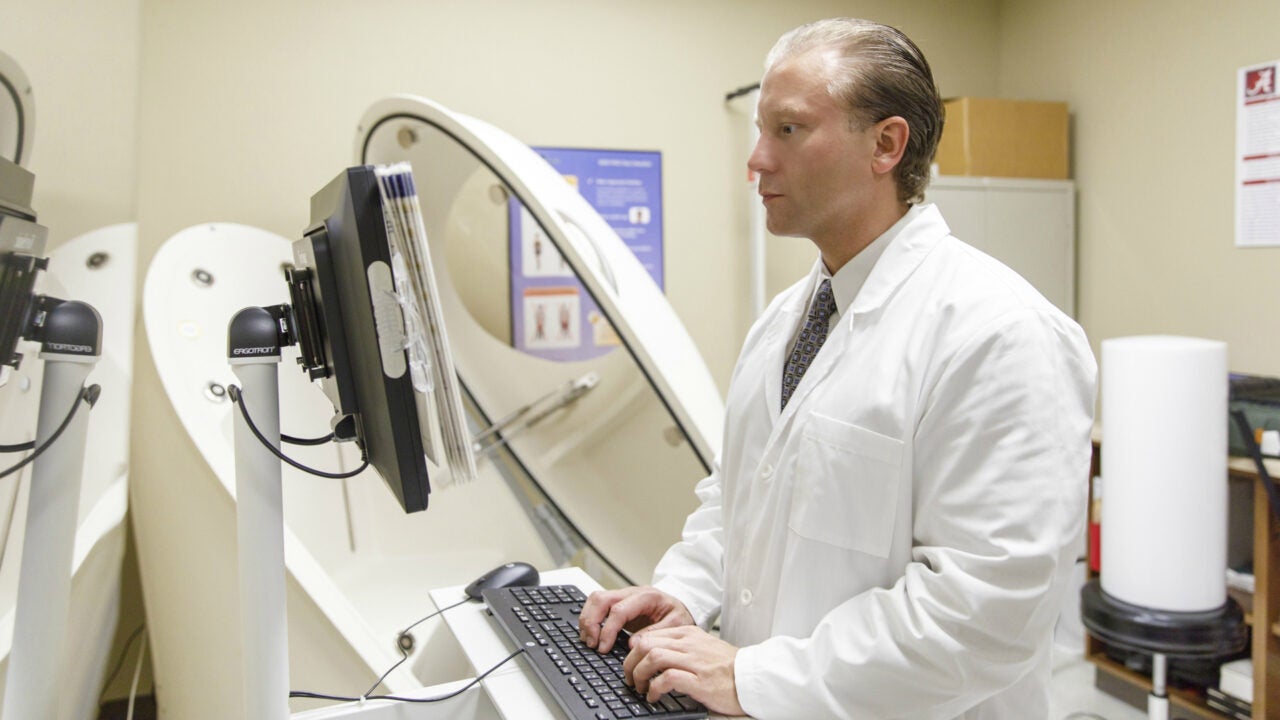TUSCALOOSA, Ala. – The benefits of quality sleep include better overall health, lowering risks of some diseases and improved mood, among others. But research at The University of Alabama found that many Alabamians are falling short of the recommended amount of sleep, with more than half of study participants meeting the clinical threshold for obstructive sleep apnea.
Dr. Adam Knowlden, director of the SLUMBRx Lab and associate professor of health science at UA, is leading the SLUMBRx study funded by the National Institutes of Health. The goal of the study is to address sleep health disparities in rural Alabama by investigating the relationship between body composition and sleep and their role in developing cardiovascular and metabolic diseases, such as diabetes, heart disease and stroke.
The early results of Knowlden’s ongoing study were recently published in JMIR Publications.
“Sleep issues were common across study participants,” said Knowlden. “One surprising finding was that 54% met the clinical threshold for obstructive sleep apnea. We determined this through home sleep testing, with results reviewed by a local sleep physician. This prevalence is notably higher than the national average, which estimates around 30 million Americans have sleep apnea.
“However, given that more than 80% of sleep apnea cases go undiagnosed, our findings suggest the number of Americans experiencing obstructive sleep apnea could potentially be much higher if all cases were detected.”

According to Knowlden, obstructive sleep apnea among participants ranged from mild to severe. He also noted that around 35% of participants had a form of insomnia.
Alabama is among the states with the highest prevalence of short sleep duration. According to the Centers for Disease Control and Prevention’s Behavioral Risk Factor Surveillance System, 43.6% of adults in Alabama report getting less than the recommended seven hours of sleep per night.
Knowlden believes it is possible rural communities experience even greater prevalence rates than urban and suburban communities.
“Alabama’s high rate of short sleep is consistent with other states in the southeast and Appalachian region, areas that also experience high levels of chronic health conditions, such as diabetes and hypertension, which are often linked to poor sleep health,” said Knowlden. “In the case of our study, we explored cardiometabolic risk factors and their relationship with sleep apnea and short sleep duration. We found blood pressure, triglycerides, blood glucose, and excess adipose tissue were all connected to the sleep health data we collected.”
Although the numbers might not paint a pretty picture, Knowlden said one of the most notable outcomes of the study was the participants’ interest in improving their sleep.
“While public awareness around sleep health is growing, many people remain unsure about the specifics of their own sleep problems — whether it’s insomnia, obstructive sleep apnea, or a combination,” said Knowlden. “Surprisingly, there’s also a lack of understanding about how to improve sleep, in contrast to other health areas like diet and exercise where general knowledge is more widespread. This gap highlights the need for future research focused on not just diagnosing sleep issues, but also providing actionable strategies and education to help people enhance their sleep quality.”
The University of Alabama, part of The University of Alabama System, is the state’s flagship university. UA shapes a better world through its teaching, research and service. With a global reputation for excellence, UA provides a forward-thinking environment and over 200 degree programs on a beautiful, student-centered campus. A leader in cutting-edge research, UA advances discovery, creative inquiry and knowledge through more than 30 research centers. As the state’s largest higher education institution, UA drives economic growth in Alabama and beyond.
Contact
Bryant Welbourne, UA Strategic Communications, bryant.welbourne@ua.edu
